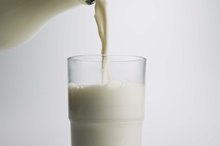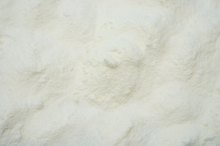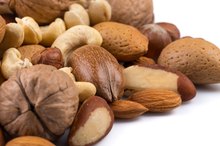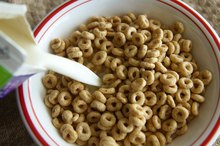What does fact checked mean?
At Healthfully, we strive to deliver objective content that is accurate and up-to-date. Our team periodically reviews articles in order to ensure content quality. The sources cited below consist of evidence from peer-reviewed journals, prominent medical organizations, academic associations, and government data.
The information contained on this site is for informational purposes only, and should not be used as a substitute for the advice of a professional health care provider. Please check with the appropriate physician regarding health questions and concerns. Although we strive to deliver accurate and up-to-date information, no guarantee to that effect is made.
How Much Protein Is in a Cup of Milk?
Milk is most closely associated with the mineral calcium, which you need to maintain strong bones and teeth. However, milk is a rich source of protein as well. According to the National Dairy Council, 1 cup of milk -– which is defined by the Dietary Guidelines for Americans as a single serving -– offers an abundance of protein, vitamin D and other essential nutrients you need for good health 5.
Your Need for Protein
Protein makes up every part of your body -– tissues, cells and organs, according to the Centers for Disease Control and Prevention. The protein in your body breaks down and continually needs to be replaced. The protein in the food you eat is made up of amino acids, of which there are 20. Your body can manufacture some of these amino acids itself, but others must be supplied by food sources. These are called essential amino acids because it's essential that you get them from your diet.
- Protein makes up every part of your body -– tissues, cells and organs, according to the Centers for Disease Control and Prevention.
- These are called essential amino acids because it's essential that you get them from your diet.
Protein in Milk
Folic Acid & Milk
Learn More
According to the U.S. Department of Agriculture's National Nutrient Database, 1 cup of nonfat milk contains 8.26 g of protein 12. The National Dairy Council states that this gives you 16 percent of your Daily Value, or DV, for protein. As an animal food, milk is considered a source of complete protein, or "high quality protein," which gives you all the essential amino acids you need.
Other Milk Benefits
One serving of milk is also rich in 8 other essential nutrients. One cup of milk provides 25 percent or more of your DV for phosphorous, riboflavin, vitamin D and calcium; and between 10 and 25 percent of your DV for niacin, vitamins A and B and potassium.
Suggested Servings
Raw Goat's Milk for Weight Loss
Learn More
According to the USDA's Food Pyramid, adults need 3 cups of milk or milk products each day; children between the ages of 2 and 8 need 2 cups. To get enough servings from the milk group, the USDA suggests drinking reduced fat or nonfat skim milk with meals or adding it to oatmeal and condensed soups in place of water. Reduced fat or nonfat milk is recommended for adults; if you're accustomed to drinking whole milk, transition to 2 percent milk, then to 1 percent milk until you finally acquire a taste for milk that's completely fat-free.
Milk for Health
Low-fat milk and low-fat chocolate milk are better for athletes than sports drinks, note Mayo Clinic nutritionists Katherine Zeratsky and Jennifer Nelson. A small number of studies show that the carbohydrates in milk, as well as its protein -– found in the whey and casein -– are better for muscle building, as well as muscle repair, after strenuous activity. If a cup of milk doesn't tempt your palate as a protein-rich snack, try unsweetened yogurt, which makes the Center for Science in the Public Interest's list of "Best Foods." Not only is yogurt a valuable source of protein, it also contains essential nutrients such as potassium, calcium and vitamin B 4.
- Low-fat milk and low-fat chocolate milk are better for athletes than sports drinks, note Mayo Clinic nutritionists Katherine Zeratsky and Jennifer Nelson.
- A small number of studies show that the carbohydrates in milk, as well as its protein -– found in the whey and casein -– are better for muscle building, as well as muscle repair, after strenuous activity.
Related Articles
References
- U.S. Department of Agriculture: National Nutrient Database
- MayoClinic.com: Milk Joins the Roster of Sports Drinks
- Center for Science in the Public Interest: Ten Worst and Best Foods
- National Dairy Council: Milk's Unique Nutrient Combination
- Milk, reduced fat (2%). FoodData Central. U.S. Department of Agriculture. Published April 1, 2019.
- Månsson HL. Fatty acids in bovine milk fat. Food Nutr Res. 2008;52. doi:10.3402/fnr.v52i0.1821
- Wadolowska L, Sobas K, Szczepanska JW, Slowinska MA, Czlapka-Matyasik M, Niedzwiedzka E. Dairy products, dietary calcium and bone health: possibility of prevention of osteoporosis in women: the Polish experience. Nutrients. 2013;5(7):2684-707. doi:10.3390/nu5072684
- Varenna M, Manara M, Galli L, Binelli L, Zucchi F, Sinigaglia L. The association between osteoporosis and hypertension: The role of a low dairy intake. Calcif Tissue Int. 2013;93(1):86-92. doi:10.1007/s00223-013-9731-9
- Cormick G, Ciapponi A, Cafferata ML, Belizán JM. Calcium supplementation for prevention of primary hypertension. Cochrane Database Syst Rev. 2015;(6):CD010037. doi:10.1002/14651858.CD010037.pub2
- National Cancer Institute. Calcium and cancer prevention. Updated May 4, 2009.
- Radavelli-Bagatini S, Zhu K, Lewis JR, Dhaliwal SS, Prince RL. Association of dairy intake with body composition and physical function in older community-dwelling women. J Acad Nutr Diet. 2013;113(12):1669-74. doi:10.1016/j.jand.2013.05.019
- Josse AR, Tang JE, Tarnopolsky MA, Phillips SM. Body composition and strength changes in women with milk and resistance exercise. Med Sci Sports Exerc. 2010;42(6):1122-30. doi:10.1249/MSS.0b013e3181c854f6
- Rautiainen S, Wang L, Lee IM, Manson JE, Buring JE, Sesso HD. Dairy consumption in association with weight change and risk of becoming overweight or obese in middle-aged and older women: a prospective cohort study. Am J Clin Nutr. 2016;103(4):979-88. doi:10.3945/ajcn.115.118406
- Flom JD, Sicherer SH. Epidemiology of cow's milk allergy. Nutrients. 2019;11(5). doi:10.3390/nu11051051
Writer Bio
Lisa Sefcik has been writing professionally since 1987. Her subject matter includes pet care, travel, consumer reviews, classical music and entertainment. She's worked as a policy analyst, news reporter and freelance writer/columnist for Cox Publications and numerous national print publications. Sefcik holds a paralegal certification as well as degrees in journalism and piano performance from the University of Texas at Austin.









